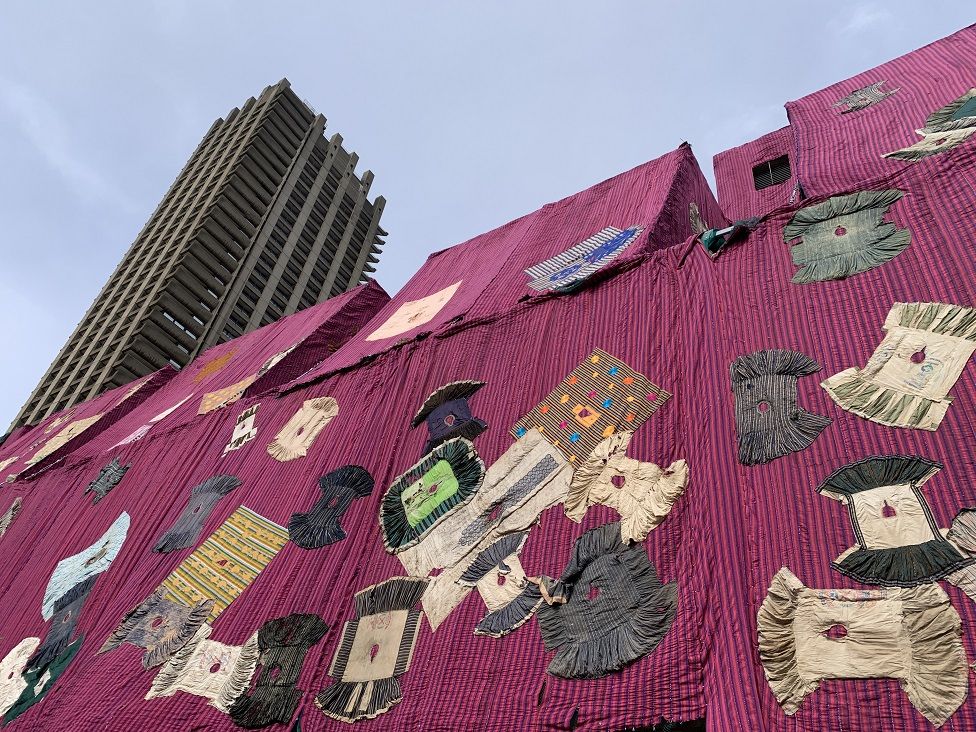Ghana's Ibrahim Mahama: The artist clothing London's brutalist icon
- Published

London's grey and angular Barbican Centre is now a sea of pink - its frontage covered in cloth that billows in the breeze as if dancing.
"It started off as a joke," visual artist Ibrahim Mahama tells the BBC.
"When I was invited here, I was looking at the grey concrete and the grey weather. I thought, why not use something more colourful as a contrast?"
So the 37-year-old turned to local experts in northern Ghana near his studio in Tamale, who weaved and sewed this project on a colossal scale.
During three months, a team of 1,000 people hand-stitched 2,000 square metres of striped cotton, before decorating it with 130 traditional smocks known as batakari.
Purple Hibiscus is the result of that toil. It is also a nod to London's famous rag trade - the city's fabric merchants, tailors and dressmakers who once dominated the area where the Barbican Centre now stands.
Ghana too has its own long and rich history of textiles - perhaps best known for its bright, patterned kente cloth.
After independence from the UK in 1957, the state initially invested in the garment and cloth industries but they later went into decline because of economic turmoil and cheap Chinese imports.
Textiles have made a comeback in recent years - despite a struggling economy - and Ghanaian fabrics are desired for their high quality and interesting designs.
"I always say that doctors repair the body, but artists fill the body with the soul. And in any society, art is the soul that drives it - to evolve in a more conscious way," says Mahama.
Community for him is key - his studio is open to visitors and he plans to open an art school for children.
Purple Hibiscus and Mahama's other large-scale public art installations reference the power of collective labour and the memories that textiles contain.
Jute sacks - used to transport cocoa, rice and charcoal - were draped over the National Theatre in Accra, Ghana's capital city. It was Mahama's way of exploring the history of trade in commodities and globalisation.
His latest project at the Barbican showcases a typically Ghanaian item he has been collecting since 2012.
Batakari - also called smocks or binŋmah in Mahama's Dagbani language - are tunics made from hand-woven strips of cotton then sewn together to create a distinctive striped pattern.
They originated in northern Ghana but are now worn throughout the country and the diaspora by men and women, on formal and informal occasions.
Some are passed down the generations - decades-old and unwashed - so "they contain the sweat, the economic struggles, the personal struggles, and the spirit of people", says Mahama.
"I like decay quite a lot. When something is at that point of its life, I always think that is when it is beginning to live more."
Among the batakari on show in Purple Hibiscus are those donated by old chiefs. Others came from ordinary families who would trade Mahama their old ones for a new one, and others still were specially commissioned.
Many bear yellowish stains of sweat - and in some cases, urine. Some families would not give Mahama their batakari until they had put urine on it because they believe that the family's past, present and future is contained in the decades-old garment.
"They believe that when they do that, it somehow desacralises the material and then the soul will somehow escape away from it," explains Mahama.
"As an artist, I think it's even more interesting aesthetically."
Mahama is in some ways more focused on the process and experience of creating art than the final product.
Crafting Purple Hibiscus was so big a task that the team worked in Tamale's sports stadium, built for the 2008 Africa Cup of Nations football tournament.
Bringing the textile creation over to London to drape on the Barbican's post-World War Two brutalist forms was a feat that makes Mahama proud.
"I thought what could be more beautiful than creating this relationship between these two labour forms - one that is coming from a post-war era, and then one that is coming from the 21st Century but also steeped in traditions and histories of the pre-colonial era."
Today it is an extraordinary sight, especially when a blue sky sets off the pink just so.
The billowing forms that batakari take when their wearers dance has always fascinated Mahama, who says they create a kind of optical effect.
It seems to me that, when the wind blows in a certain way, Purple Hibiscus is performing its own special dance.
Penny Dale is a freelance journalist, podcast and documentary-maker based in London.
Purple Hibiscus is at the Barbican until 18 August, as part of Unravel: The Power and Politics of Textiles In Art, which is open until 26 May.